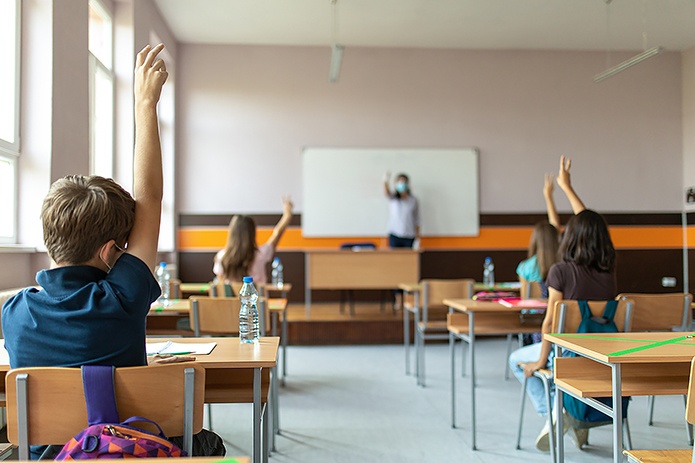
When a student steps onto a school bus, they have entered an important component of a school’s facilities. School buses are the safest way to travel to and from school and are the only transportation option for some students. Students spend a considerable amount of their school day on the school bus, so how does the air quality in a school bus compare to the air quality in other areas of a school’s facilities? “If a student on one of our buses tests positive for COVID-19, all the students within 6-feet of that student must quarantine, just like they would in the classroom,” said Bob Martin, Director of Transportation at Community School Corporation of Southern Hancock County in Indiana. So, why shouldn’t the air quality in the school bus be as good as it is in the math classroom, or the cafeteria?
This question is timely, as school systems are in the process of determining how to best allocate the large amount of ESSER COVID funds they’ve been provided to improve the air quality in their facilities and ensure that their facilities are prepared for and avoid potential closures in the future.
There is broad consensus today that the primary method of COVID-19 transmission is through the air. The Wells-Riley model was developed by William F. Wells and Richard L. Riley in the late 1970’s to quantify the risks associated with airborne transmission of respiratory diseases. The variables that affect the likelihood of infection transmission include time, the infectivity of the disease, and the concentration of airborne infectious particles. Since time and the infectivity of the disease are not easily controlled in educational settings, how can we control the concentration of infectious particles?
The American Society of Heating, Refrigerating and Air-Conditioning Engineers (ASHRAE) is the recognized industry association that establishes standards for ventilation, filtration and indoor air quality. ASHRAE’s guidelines help set building codes and influence the CDC and public health officials. Requirements for air quality in classrooms, the gym, cafeteria, and other areas of a school’s facilities have been developed over many years, and have been updated recently with learnings from the latest pandemic.
The guidelines for indoor air quality center around 1) diluting indoor contaminants by bringing in clean outside air, 2) filtering contaminants out of recirculated air, and 3) supplementing with air cleaners that have a proven safety and efficacy, especially when it’s difficult to accomplish #1 and #2.
Air Quality in Buildings
Ventilation (Outside Air)
ASHRAE 62.1 Ventilation for Acceptable Indoor Air Quality1 has been adopted as code throughout the U.S. and sets guidelines for outside air, which dilutes indoor contaminants. A classroom should bring in 10 cubic feet of clean outside air every minute for the number of people in that space, plus 0.12 cubic feet per minute per square-foot of the space. In our example, shown in Figure 1, that works out to 500 cubic feet of clean outside air into the classroom every minute.

ASHRAE 62.1 also states that the outside air intake for the classroom must be more than 25 feet away from a thoroughfare with high traffic, or a bus idling area. The U.S. Environmental Protection Agency (EPA) warns against bringing outside air near roadways into classrooms. “Pollutants directly emitted from cars, trucks, and other motor vehicles are found in higher concentrations near major roads.” “Children are particularly susceptible to health problems due to … respiratory systems that are not fully developed.”2

If we applied ASHRAE 62.1 criteria for outside air to a full-size school bus, we would need 800 cubic feet of clean outside air to be brought into the school bus every minute. Acknowledging that we cannot meet ASHRAE and the EPA standards for the quality of outside air since the bus cannot be greater than 25 feet away from a road or bus idling area, what about the quantity of outside air? Bus drivers do not have control of student’s windows, so a student can close their window for any reason, including outside conditions like rain, temperature, wind, or noise. While some smaller buses have dash HVAC systems that can bring in a little outside air, most buses, even those with air conditioning, only recirculate air. No outside air is brought in through a typical school bus’s heating or air-conditioning systems.
During a pandemic and with no better option, it is advisable to open bus windows and bring polluted outside air into buses to dilute indoor contaminants. But, schools have been given funds to ensure they DO have better options.
Filtration

ASHRAE recommends a minimum MERV-13 filter for the reopening of classrooms.3 Filters are rated on MERV levels from low to high, based on the particles they remove. Dr. Brent Stephens of the Illinois Institute of Technology published a report for the National Air Filtration Association, titled “HVAC filtration and the Wells-Riley approach to assessing risks of infectious airborne diseases.”4 The report concludes that MERV-13 filters remove 87-percent of total droplet nuclei expelled during human activities. Typical school bus filters are about MERV-2, which are not effective at removing pathogens, and are meant solely to keep HVAC coils from fouling.
Transportation Recommendations
Dr. William Bahnfleth, chair of the ASHRAE Epidemic Task Force, testified before the House Committee on Transportation and Infrastructure earlier this year. During his testimony, he said, “The density of people (in transportation environments) is ordinarily much higher than in buildings. This density inherently increases the risk of short-range transmission, and it is difficult, if not impossible, to isolate passengers.” He also stated, “Code minimum ventilation and MERV-13 filter efficiency should be viewed as baseline requirements that may not be sufficient. … Air cleaners may be used as a supplement. The best-established technology (to supplement ventilation and filtration) currently is disinfection with germicidal ultraviolet light.”5
Density
A typical classroom for 25 students is roughly 1,050 square feet with a 9-foot ceiling, amounting to 378 cubic feet per student. A typical 77-passenger school bus transporting 50-students would have only 34 cubic feet per student. The density in the school bus is like having 270-students in a classroom meant for 25. Can you imagine putting 270 students in a classroom meant for 25? The higher people density of the school bus, would make you think the air quality requirements for school buses are more stringent than those for classrooms, but that isn’t the case. A transportation director in Florida recently commented, “It’s puzzling to see a group of students step off a tightly packed bus and have a teacher tell them to spread out and stay 6 feet apart as they enter the building.”

Solutions
Air conditioning systems on buses are currently not capable of bringing in the code minimum amount of clean outside air that is required for classrooms. The good news is that there are options available to improve filtration efficiency and supplement with air cleaning devices.

When upgrading the filtration on your buses, try to achieve the highest Clean Air Delivery Rate possible. Clean Air Delivery Rate (CADR) is a product of the airflow that is being cleaned and the efficiency of the filter. Using Figure 2 above for filter efficiency, a HEPA filter at 400-cfm, would have a CADR of 400. A system that cleaned 1,300-cfm of air with a MERV-13 filter would have a CADR of 1,131, or almost 3-times as much. Also take into account operational expenses including material and labor for filter changes, and the noise level of the filtration device. Replacement filters, especially HEPA filters, can be quite expensive. For safety, make sure the noise levels of filtration devices are acceptable and are tied into noise suppression switches.
UV is the only air cleaning technology specifically recommended as a supplement by the CDC.6 UV has been used for over 80-years to effectively and safely inactivate pathogens. The CDC website on Ventilation states that UV kills viruses, including SARS-CoV-2, which causes COVID-19. There are also practical guidelines on the CDC’s website of how to safely apply UV, making sure UV shines on pathogens, not on occupants and materials. Many companies offer UV solutions, and CADR can also be used to compare UV offerings. The CDC encourages consumers to exercise caution and do their homework regarding numerous other technologies being heavily marketed, including ionization, dry hydrogen peroxide, and chemical fogging.7 Recently released data by three major universities concluded the ionizing devices they tested were ineffective in reducing small particles and had an unintended consequence of increasing some levels of dangerous VOC’s8. Some members of ASHRAE’s Epidemic Task Force have written an open letter asking school systems not to purchase these electronic air cleaners, and to turn them off if they’ve been installed.9 The letter was endorsed by many scientists and health professionals and has prompted class action lawsuits against some companies making these devices.10

In conclusion, the school bus is an important part of a school’s facilities. Why should the air quality on the school bus be worse than air quality in the school’s gym, cafeteria or classrooms, especially considering the high density of students on the bus?
Options to bring in clean outside air are not currently available for school buses. However, filtration and air cleaning devices can improve the bus’s air quality. Filtration levels in school buses should be increased to at least MERV-13 which are the same levels recommended for the rest of the school’s facilities. Due to the high people density and poor options for outside air ventilation available for buses, UV should be used as an air cleaning supplement.

The most dramatic improvements to air quality in school system’s facilities can be made by improving air in their school buses. If school systems spent a little over 1 percent of their ESSER COVID money on average on their school buses, they could have a 12-year solution, including all necessary replacement filters and UV bulbs, improving health, and helping to protect against future shutdowns.
1- ASHRAE 62.1 Ventilation for Acceptable Indoor Air Quality, American Society of Heating Refrigeration and Air Conditioning Engineers
4- “HVAC filtration and the Wells-Riley approach to assessing risks of infectious airborne diseases” Dr Brent Stephens, Department of Civil, Architectural and Environmental Engineering Illinois Institute of Technology, March 1, 2012
6- https://www.cdc.gov/coronavirus/2019-ncov/community/ventilation.html
7- https://www.cdc.gov/coronavirus/2019-ncov/community/ventilation.html FAQ’s
9- https://medium.com/open-letter-to-address-the-use-of-electronic-air/no-to-ionizers-plasma-uvpco-bc1570b2fb9b Based on $190 billion in funds for over 470,000 school buses
10- https://www.bloomberglaw.com/public/desktop/document/vGarneretalDocketNo121cv00665DDelMay072021Court
Docket?162069624
Dan Fillenwarth is the president of Lumin-Air, a company that specializes in air cleaning systems for buildings and public transportation. Visit www.lumin-air.com for more information.


